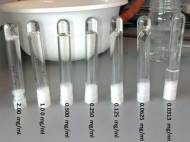Bioinspired gel with helical polymers acts opposite to gelatine
 Our life experience has taught us that materials around us melt or turn into vapor when we heat them, but a group of chemists at Radboud University Nijmegen managed to create a super gel which stiffens when it is warmed. Once it is cooled bellow the projected threshold, the gel melts back into the liquid state. The researchers are cooperating with the business community in order to develop various biomedical applications for this extraordinary gel.
Our life experience has taught us that materials around us melt or turn into vapor when we heat them, but a group of chemists at Radboud University Nijmegen managed to create a super gel which stiffens when it is warmed. Once it is cooled bellow the projected threshold, the gel melts back into the liquid state. The researchers are cooperating with the business community in order to develop various biomedical applications for this extraordinary gel.
Inspired by the proteins that provide the cells in our bodies with their strength, Nijmegen chemists Prof. Alan Rowan and Dr Paul Kouwer mimicked the winding structure of these proteins using a synthetic polymer – polyisocyanide (PIC). Chemists at Radboud University Nijmegen have created a gel made from helical polymers. The molecules twist together to form a nanosized rope from which strong, stiff networks are produced.
“When we first produced the material in the laboratory two years ago we knew that it was a very special substance, but did not yet understand why. The follow-up research has produced some fantastic results”, said Rowan.
Resulting polymer matches the properties of the natural original, and its structure provides the polymer with its unusual gel response – less than one gram (0.035 ounces) of the solid substance needs to be added to a bucket of water to produce a strong gel. In comparison, gel response of the newly developed material is one hundred times better than current commercially used super gels.
Since the transition temperature of the solution can be varied between room temperature and body temperature, the gel could find various applications in biomedicine. In cooperation with a Dutch company Noviotech, a commercial partner of the Radboud University Nijmegen and Radboud University Nijmegen Medical Centre, the researchers are devising potential applications for the gel.
“One application is as a medium for the growth and manipulation of cells. Another potential application is in wound treatment. Once applied, the gel protects the wound: the microscopic structure allows fluid to pass through but keeps bacteria out. Once the wound has healed, the ‘plaster’ can be easily removed by cooling the gel”, said Rowan.
For more information about the research, read the article published in the journal Nature: “Responsive biomimetic networks from polyisocyanopeptide hydrogels”.
For more information regarding synthesis, characterization and measurements, you can read the research supplementary information [1.19MB PDF].










Leave your response!